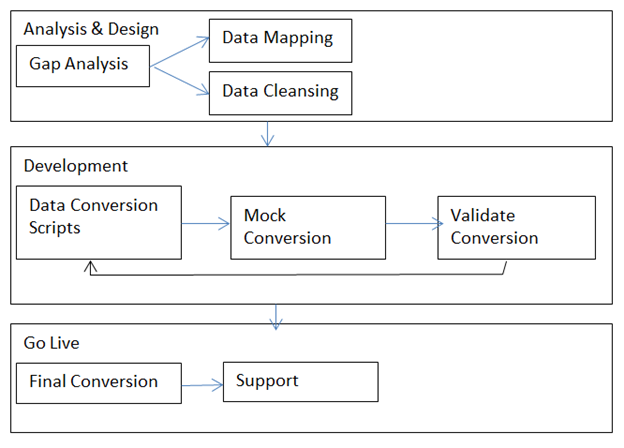Data conversion methodology typically comprises of three phases as outlined in the below diagram
Phase 1: Analysis & Design
Phase 2: Development
Phase 3: Go Live
Phase 1: Analysis & Design
In this phase we do an in-depth qualitative and quantitative gap analysis of source systems and data structure model. This phase provides us critical detailed insight into source data. Based on the analysis, a decision is required to be taken in this phase as to whether there is a necessity of data cleansing, level of data cleansing for maximum migration and the corresponding tradeoffs.
During this phase we will also understand the architecture of the existing data and evaluate data to identify potential anomalies and major complications. We also identify conversion patterns and come up with a set of mappings and transform algorithms along with the business rules that will convert and migrate data. During subsequent phases these will be refined as the requirements and consequences evolve.
At the end of this phase we perform Data Mapping and Data Cleansing activities parallel as outlined below:
Data Mapping
During this activity we perform the data mapping of the source data elements with the target data elements. While mapping, we examine and address data elements required by target system but unavailable in the source system and business critical data needed from the source system which does not have a defined place in the target system. Along with business analysts and technical teams we formulate the data mapping rules. This data mapping activity is an iterative process till the consensus for all the data elements are reached.
Data Cleansing
The data cleansing is critical in the success of this data conversion. As per the necessity the data cleansing activity will be started in this phase. It should be appreciated that data cleansing is an iterative process and may require generous time scales for improvement in data quality. This activity involves business analysts to work closely with us. This cleansing activity will be done parallel to the Data Mapping and also overlaps with the next phase. The data cleansing can be manual or through automated scripts.
Phase 2: Development
This is the most important phase of data conversion process. Based on the mapping specifications and rules we develop conversion scripts. During this phase we need to identify all the conversion issues during and formulate appropriate conversion strategies such as update data mapping rules, risk mitigation and contingency plans.
Once the conversion scripts are developed, we will perform a mock conversion and validate the conversion. The data conversion scripts development, mock conversion and validate conversion is an iterative process and will be performed till the desired conversion is achieved and accepted.
Phase 3: Go Live
At the end of the data conversion and before the cut over for the target system we will perform a final conversion during a planned downtime. After going into production with the new system solution we will also provide support for unforeseen data issues, if any.
Phase 1: Analysis & Design
Phase 2: Development
Phase 3: Go Live
Phase 1: Analysis & Design
In this phase we do an in-depth qualitative and quantitative gap analysis of source systems and data structure model. This phase provides us critical detailed insight into source data. Based on the analysis, a decision is required to be taken in this phase as to whether there is a necessity of data cleansing, level of data cleansing for maximum migration and the corresponding tradeoffs.
During this phase we will also understand the architecture of the existing data and evaluate data to identify potential anomalies and major complications. We also identify conversion patterns and come up with a set of mappings and transform algorithms along with the business rules that will convert and migrate data. During subsequent phases these will be refined as the requirements and consequences evolve.
At the end of this phase we perform Data Mapping and Data Cleansing activities parallel as outlined below:
Data Mapping
During this activity we perform the data mapping of the source data elements with the target data elements. While mapping, we examine and address data elements required by target system but unavailable in the source system and business critical data needed from the source system which does not have a defined place in the target system. Along with business analysts and technical teams we formulate the data mapping rules. This data mapping activity is an iterative process till the consensus for all the data elements are reached.
Data Cleansing
The data cleansing is critical in the success of this data conversion. As per the necessity the data cleansing activity will be started in this phase. It should be appreciated that data cleansing is an iterative process and may require generous time scales for improvement in data quality. This activity involves business analysts to work closely with us. This cleansing activity will be done parallel to the Data Mapping and also overlaps with the next phase. The data cleansing can be manual or through automated scripts.
Phase 2: Development
This is the most important phase of data conversion process. Based on the mapping specifications and rules we develop conversion scripts. During this phase we need to identify all the conversion issues during and formulate appropriate conversion strategies such as update data mapping rules, risk mitigation and contingency plans.
Once the conversion scripts are developed, we will perform a mock conversion and validate the conversion. The data conversion scripts development, mock conversion and validate conversion is an iterative process and will be performed till the desired conversion is achieved and accepted.
Phase 3: Go Live
At the end of the data conversion and before the cut over for the target system we will perform a final conversion during a planned downtime. After going into production with the new system solution we will also provide support for unforeseen data issues, if any.
